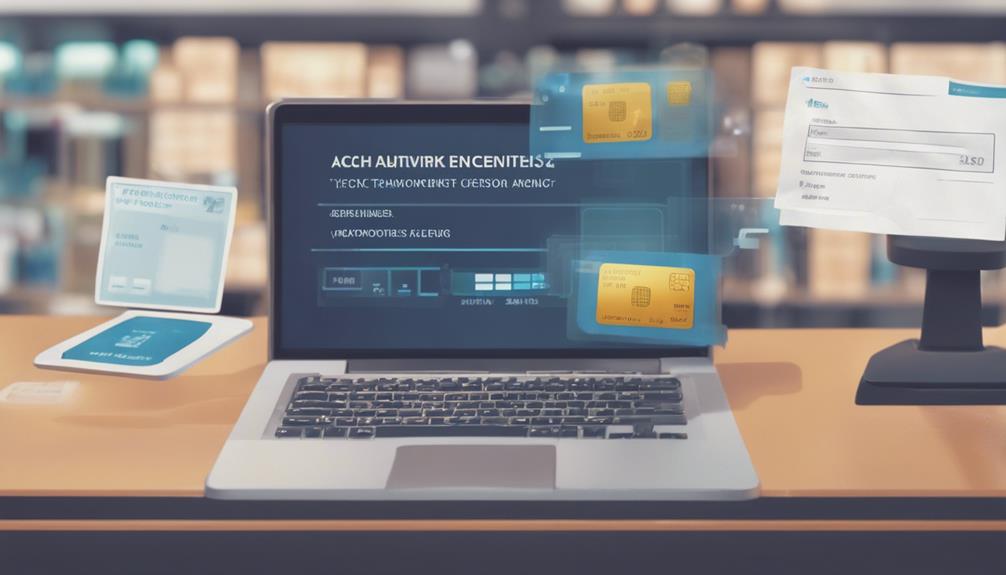In the ACH network, ODFIs and RDFIs play important roles in electronic payments. ODFIs initiate transactions, receiving instructions from clients and creating ACH entries. On the other hand, RDFIs verify transactions, confirm fund availability, and guarantee security. Their collaboration is essential for the network's efficiency. RDFIs meticulously examine ACH files, safeguard against fraud, and contribute to trust in transactions. Enhancements include real-time monitoring, improved communication channels, regulatory compliance, risk assessments, and staff training. Understanding these roles reveals the backbone of electronic payment systems, highlighting the essential responsibilities and collaborative efforts between ODFIs and RDFIs. Further insights await.
Key Takeaways
- ODFIs initiate ACH transactions based on client instructions.
- RDFIs verify transaction details and ensure funds availability.
- ODFIs create ACH entries for processing by RDFIs.
- RDFIs play a crucial role in safeguarding against errors and fraud.
- Collaboration between ODFIs and RDFIs is vital for ACH network efficiency.
Understanding ODFIs in ACH Network

In the ACH network, ODFIs, as financial institutions, play a crucial role in initiating electronic payments. ODFIs act as the starting point for transactions, receiving funds from clients and creating ACH debit and credit entries. These institutions are responsible for sending the funds to the recipients' accounts, ensuring the smooth flow of payments.
ODFIs are pivotal in the ACH network, as they're the ones who kickstart the entire process of electronic fund transfers. By collaborating with other entities within the network, ODFIs contribute to the efficiency, security, and transparency of financial transactions. Their role is essential in facilitating seamless fund transfers and maintaining the integrity of the ACH system.
Exploring RDFIs' Role in ACH

Exploring how RDFIs facilitate electronic payment processing within the ACH network enhances understanding of the network's operational dynamics and efficiency.
RDFIs, or Receiving Depository Financial Institutions, play a crucial role in the ACH system. Upon receiving ACH files from ODFIs, RDFIs meticulously verify transaction details and guarantee the availability of funds for payment. They then credit these funds to the recipients' accounts promptly.
This careful validation process by RDFIs helps safeguard against errors and fraud, contributing to the network's overall security and reliability.
Efficient coordination between ODFIs and RDFIs is essential for successful fund transfers, emphasizing the importance of their collaboration in ensuring seamless electronic transactions for businesses, individuals, and government entities.
ODFIS Vs. Rdfis: ACH Initiators

ODFIs and RDFIs serve as key initiators in the ACH network, facilitating electronic fund transfers between parties. ODFIs, or Originating Depository Financial Institutions, play an important role in initiating ACH transactions. They receive payment instructions from clients, create ACH entries, and submit these transactions to the ACH network for processing.
On the other hand, RDFIs, or Receiving Depository Financial Institutions, receive the ACH files containing transaction details, verify the authenticity of transactions, confirm funds availability, and credit the recipients' accounts accordingly. ODFIs initiate the movement of funds, while RDFIs receive and process these transactions, ensuring the successful transfer of funds between parties.
This collaborative effort between ODFIs and RDFIs is essential for the smooth operation of the ACH network.
Key Responsibilities of RDFIs

Responsibilities of RDFIs encompass verifying transaction details and confirming funds availability for successful electronic fund transfers. Upon receiving ACH files, RDFIs meticulously examine transaction information to validate accuracy and compliance. They play a critical role in validating that the necessary funds are present in the recipient's account before crediting the amount.
RDFIs also guarantee that transactions adhere to regulations and security protocols, safeguarding against fraudulent activities. By diligently performing these tasks, RDFIs contribute to the smooth functioning of the ACH network, promoting trust and efficiency in electronic payments. Their dedication to thorough scrutiny and financial responsibility underpins the reliability of fund transfers, benefiting both senders and recipients in the electronic payment ecosystem.
Enhancing ACH Transfers With Odfis/Rdfis

Building upon the foundation of efficient electronic fund transfers established by RDFIs, enhancing ACH transfers with ODFIs and RDFIs involves seamless coordination and optimized processes for swift and secure transactions.
To enhance ACH transfers effectively, consider the following strategies:
- Implement real-time transaction monitoring.
- Enhance communication channels between ODFIs and RDFIs.
- Regularly update systems to guarantee compliance with ACH regulations.
- Conduct thorough risk assessments to mitigate potential vulnerabilities.
- Invest in staff training to stay updated on industry best practices and technological advancements.
Frequently Asked Questions
How Do ODFIS and RDFIS Handle ACH Transaction Disputes?
When handling ACH transaction disputes, ODFIs and RDFIs follow specific protocols. ODFIs investigate client concerns and may request additional information.
RDFIs review transaction details and verify if the payment was authorized. Communication between ODFIs and RDFIs is crucial in resolving disputes efficiently.
If discrepancies persist, a formal dispute resolution process may be initiated. Collaboration and thorough examination help guarantee fair outcomes for all parties involved in ACH transactions.
Can ODFIS or RDFIS Reverse an ACH Transaction if Needed?
ODFIs and RDFIs can reverse an ACH transaction when needed. If there's an error or unauthorized transaction, ODFIs can initiate a reversal process to return funds.
RDFIs, upon receiving the reversal request, investigate and may credit the funds back to the sender's account. Understanding the reversal process and adhering to ACH network rules is essential for both ODFIs and RDFIs to manage transaction reversals effectively.
What Measures Do ODFIS and RDFIS Take to Prevent Fraud in ACH Transfers?
ODFIs and RDFIs implement various measures to prevent fraud in ACH transfers. ODFIs employ robust authentication processes for transaction initiation.
RDFIs meticulously verify transaction details and guarantee adequate funds. Both parties monitor for suspicious activities, conduct thorough audits, and adhere to industry regulations.
Collaborative efforts between ODFIs and RDFIs bolster security, aiming to safeguard the integrity of ACH transactions and protect stakeholders from fraudulent activities.
Do ODFIS and RDFIS Charge Fees for Processing ACH Transactions?
ODFIs and RDFIs typically charge fees for processing ACH transactions, varying based on services rendered. While ODFIs may charge origination fees, RDFIs often have receipt fees. These charges help cover operational costs within the ACH network.
Understanding these fees is important for businesses and individuals utilizing ACH payments to manage their financial transactions efficiently. Clear communication with both ODFIs and RDFIs can guarantee transparency regarding these fees and their impact on transfers.
How Do ODFIS and RDFIS Ensure Compliance With ACH Network Rules and Regulations?
ODFIs and RDFIs uphold compliance with ACH network rules by following regulatory guidelines. ODFIs initiate transactions following established protocols, verifying data accuracy and authorization.
RDFIs validate received entries, confirming sufficient funds and proper crediting. Both institutions maintain strict adherence to ACH regulations, promoting transparency and security in electronic fund transfers.
Effective collaboration between ODFIs and RDFIs is key to upholding regulatory standards and facilitating seamless ACH transactions.
Conclusion
To summarize,
ODFIs and RDFIs play crucial roles in the ACH network, ensuring seamless fund transfers for individuals and businesses.
Their collaboration enhances the efficiency and security of electronic payments, benefiting all parties involved.
By understanding the distinct functions of ODFIs and RDFIs, users can navigate the ACH system with ease and confidence.
Remember, in the world of electronic payments, knowing the ins and outs of ODFIs and RDFIs is key to successful transactions.










